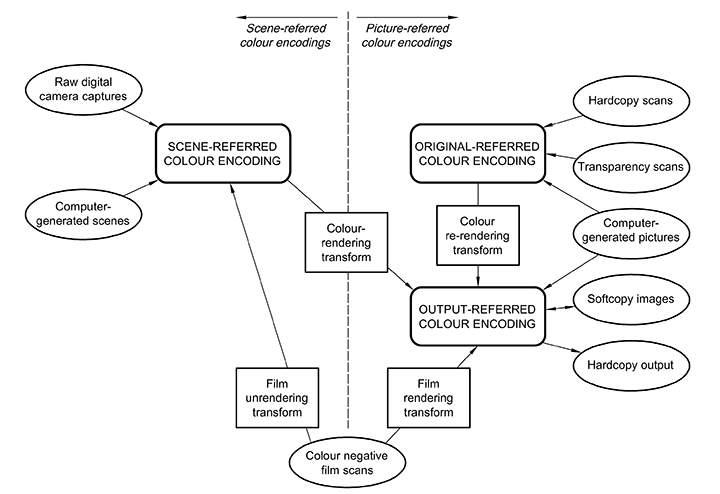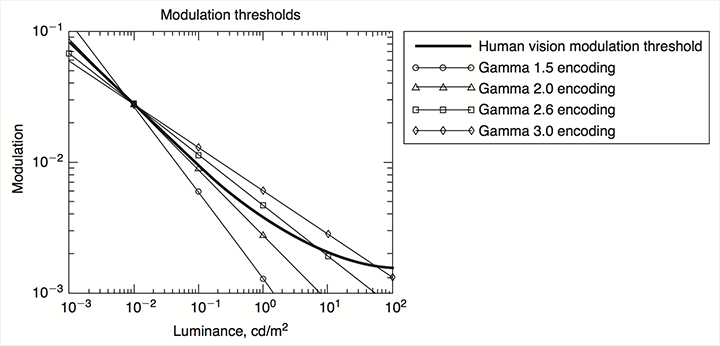Scene Linear Workflow/ACES is a workflow with a color pipeline based around scene linear images. Scene-linear images are images that are relatively referenced to the light of the real scene and do not contain context-sensitive sensory values such as desirability. Scene linear images can be classified as scene-referred image states. So, what kind of image state workflows existed before scene linear workflows became popular?

ISO 22028-1. ” Image state diagram showing relationship between various types of colour encodings ” 2004. p6
In the conventional video production workflow, images generated by a camera are projected on a display, observed, digitally processed, and the processed results are included in the image. The image data generated in this process is a complex combination of all factors related to the image work, including the technical specifications of the camera, the technical specifications of the display and the environment in which the image is observed, the desirability of the artist who applies the image processing, and the context of the work, which is also true of computer graphics images. All images produced by such a workflow can be broadly classified into output-referred image states.
There are standard technical specifications for real-world displays on which workflows with output-referred images will rely heavily. In a typical display, the relationship between the input code value (X) and the output luminance (Y) has a property that can be approximated in a simple power function (Y=Xγ). The exponent value of this power function is called gamma, and using the CRT (cathode ray tube) as an example, which was the master monitor for conventional video production, its characteristics can be approximated by a gamma of approximately 2.4. When displaying video or CGI on a display, the gamma characteristic of the display is always present*2.
On the other hand, what are the characteristics of human vision when observing a display? When observing light, human vision has a threshold for luminance change of approximately 1%. When the threshold is exceeded, banding artifacts are observed instead of smooth tones. If the gamma characteristic of a display is linear in an 8-bit display (256 levels), such artifacts are easily observed in the midtones and shadows below the code value of 1003. Therefore, even in a traditional workflow using 8-bit output-referred images, where it is difficult to maintain rich tones such as OpenEXR, the use of a display with CRT-like gamma characteristics will result in images with an efficiency that naturally approximates the visual characteristics. The use of displays with gamma characteristics such as CRTs naturally results in images having efficient code values that approximate visual characteristics, and as a result, video production that barely meets visual requirements has been realized. In digital cinema, too, one of the technical specifications for projectors, gamma 2.6, has been determined based on visual research as described in the SMPTE guidelines5.

Color and Mastering for Digital Cinema. ” Human Vision Modulation Threshold and Equations with Various Gamma Values ” 2006. p50 *6
In the traditional workflow, the characteristics of digital equipment and the artist’s subjectivity have always been inseparable elements. This can be described as a chaotic video production in which the analog processes of traditional art, such as painting and sculpture, are directly replaced by the digital process. On the other hand, the scene linear workflow, which is based on the physical characteristics of the real world, breaks down the chaotic video production process into smaller pieces, and by once removing the characteristics of the equipment and the artist’s subjectivity, objective and universal video production becomes possible. It is important to emphasize that the scene linear workflow is based on the mechanisms of human vision, while being physical and objective. The scene linear workflow unifies digital images into physically accurate data, and then adds visual effects based on human senses to this scene linear data to create VFX images with unprecedented vividness. Furthermore, the scene linear workflow is the foundation for collaboration with cutting-edge researchers in other fields, such as psychologists and engineers.
The transition from a traditional workflow to a scene-linear workflow involves a rigorous process that requires the abandonment of various elements based on the artist’s subjective viewpoints that have been cultivated over time. Only by reserving the artist’s senses, sensibilities, and imagination can a scene-linear workflow be established. Therefore, this drastic transition must be done with extreme caution.
1) ISO 22028-1. “Photography and graphic technology — Extended colour encodings for digital image storage, manipulation and interchange — Part 1: Architecture and requirements” 2004.
2) Charles Poynton. ‘Gamma in CRT physics’ in “Digital Video and HD, Second Edition: Algorithms and Interfaces” Kindle Edition. 2012.
3) Charles Poynton. ‘The “ code 100 ” problem and nonlinear image encoding’ in “Digital Video and HD, Second Edition: Algorithms and Interfaces” Kindle Edition. 2012.
4) Naoya Kato. SONY “Color Imaging” p52. 2004.
5) SMPTE EG 432-1-2007. ‘Reason for the Constant 2.6’ in “Digital Source Processing — Color Processing for D-Cinema” 2007.
6) Glenn Kennel. ‘Transfer Function’ in “Color and Mastering for Digital Cinema” 2006.
